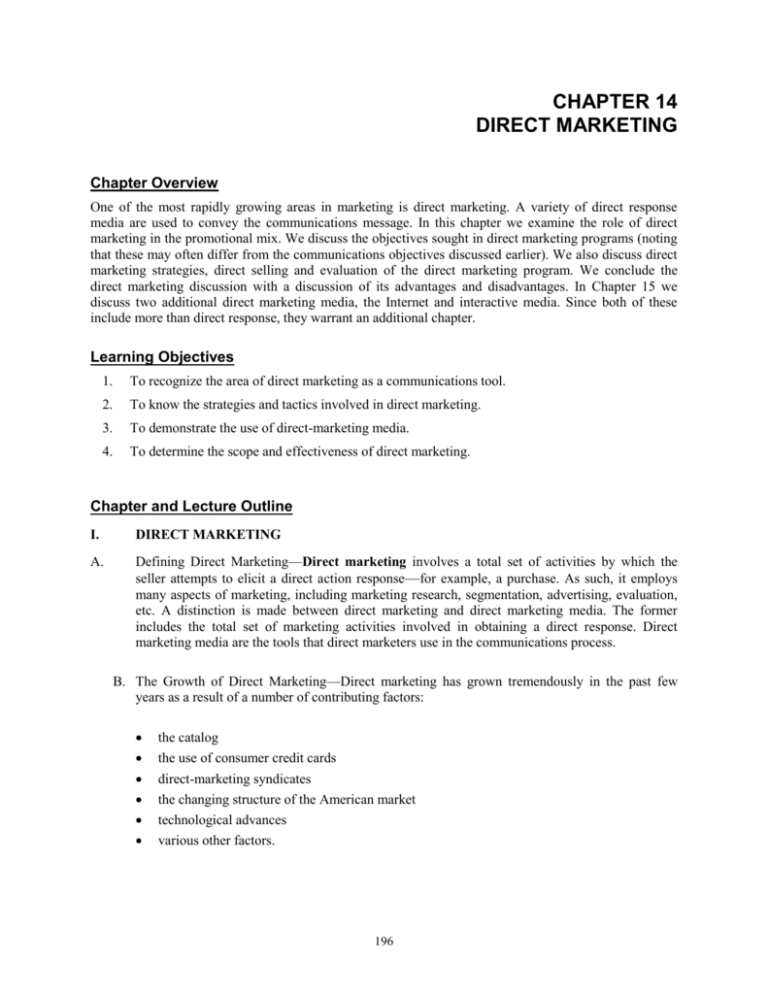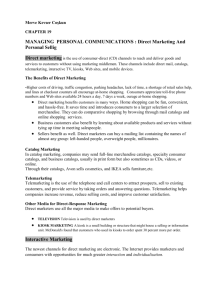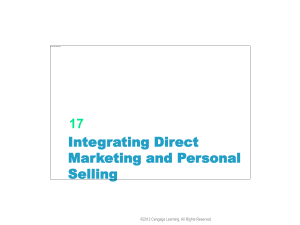i. direct marketing
advertisement

CHAPTER 14 DIRECT MARKETING Chapter Overview One of the most rapidly growing areas in marketing is direct marketing. A variety of direct response media are used to convey the communications message. In this chapter we examine the role of direct marketing in the promotional mix. We discuss the objectives sought in direct marketing programs (noting that these may often differ from the communications objectives discussed earlier). We also discuss direct marketing strategies, direct selling and evaluation of the direct marketing program. We conclude the direct marketing discussion with a discussion of its advantages and disadvantages. In Chapter 15 we discuss two additional direct marketing media, the Internet and interactive media. Since both of these include more than direct response, they warrant an additional chapter. Learning Objectives 1. To recognize the area of direct marketing as a communications tool. 2. To know the strategies and tactics involved in direct marketing. 3. To demonstrate the use of direct-marketing media. 4. To determine the scope and effectiveness of direct marketing. Chapter and Lecture Outline I. DIRECT MARKETING A. Defining Direct Marketing—Direct marketing involves a total set of activities by which the seller attempts to elicit a direct action response—for example, a purchase. As such, it employs many aspects of marketing, including marketing research, segmentation, advertising, evaluation, etc. A distinction is made between direct marketing and direct marketing media. The former includes the total set of marketing activities involved in obtaining a direct response. Direct marketing media are the tools that direct marketers use in the communications process. B. The Growth of Direct Marketing—Direct marketing has grown tremendously in the past few years as a result of a number of contributing factors: the catalog the use of consumer credit cards direct-marketing syndicates the changing structure of the American market technological advances various other factors. 196 C. The Role of Direct Marketing in the IMC Program—Direct marketing activities support and are supported by other elements of the promotional mix. 1. Combining direct marketing with advertising—Direct marketing is in itself a form of advertising. Whether through mail, print, or TV, the direct-response offer is an ad. Sometimes the ad supports the direct selling effort (i.e. Victoria Secret runs image ads to support its store and catalog sales.) 2. Combining direct marketing with public relations—Private companies may use telemarketing activities to solicit funds for charities or cosponsor charities that use these and other direct response techniques to solicit funds. 3. Combining direct marketing with personal selling—Nonprofit organizations often use telemarketing to solicit funds. 4. Combining direct marketing with sales promotions—For example, airlines send out mailers announcing promotional airfares. D. Direct-Marketing Objectives—Direct marketers seek a direct response. This response need not necessarily be a behavioral response, as direct marketing is now used for other purposes: to build an image, maintain customer satisfaction, and inform and/or educate customers in an attempt to lead to future actions (see Exhibit 14-1.) E. Developing a Database—One of the most important parts of the direct marketing program is the development of a database. The database is the foundation from which direct marketing decisions evolve. Figure 14-2 demonstrates how database marketing works. Databases are used to perform the following functions: Improving the selection of market segments Stimulate repeat purchases Cross-sell Sources of database information are listed on pages 469-470. F. Direct Marketing Strategies and Media—Direct marketers generally pursue either a (1) one-step approach or a (2) two-step approach in developing media strategies. In the one-step approach, the medium is used to directly obtain an order (for example, direct response television ads). In the two-step approach, more than one medium may be used, with the first effort designed to screen or qualify buyers and the second designed to generate the response. A number of direct response media are available to the marketer including: 1. Direct mail—Mail order sales exceeded $582 billion in 2001, and approximately half of this was in the consumer market. Keys to the success of direct mail are the mailing list and the ability to segment markets. 2. Catalogs—Catalog sales are projected to reach $16 billion by the year 2006. The text lists several examples on page 475 that can be discussed in class. 197 3. Broadcast media—Two broadcast media are available to direct marketers: TV and radio. The majority of direct marketing broadcast advertising now occurs on TV, which receives the bulk of our attention in the text 4. Infomercials—The lower cost of commercials on cable and satellite channels has led advertisers to a new form of advertising. Figure 14-5 shows the results of a study by Naveen Donthu and David Gilliland profiling infomercial viewers and buyers. 5. Teleshopping—The major shopping channels in the United States—QVC, and the Home Shopping Network, —account for over $3.9 billion worth of sales, though there are indications that this medium may have already reached maturity. 6. Print media—Magazines and newspapers are difficult media to use for direct marketing because of clutter and the relative expense. 7. Telemarketing—Over $661 billion dollars worth of sales took place through telemarketing phone calls in 2001. Telemarketing continues to grow, particularly in the business-to-business sector, which accounted for about 2/3 of the sales dollars. 8. Electronic teleshopping—an on-line shopping and information retrieval service accessed through personal computers. The Internet, the most popular of these tools, is discussed in the next chapter. Professor’s Notes II. DIRECT SELLING Direct selling involves the direct, personal presentation, demonstration and sales of products and services to consumers in their homes. The text discusses three forms of direct selling including: 1. Repetitive person-to-person selling—Amway 2. Nonrepetitive person-to-person selling – Encyclopedia Brittanica 3. Party plans—Tupperware A demographic profile of the direct salesperson is provided on page 479. Professor’s Notes 198 III. EVALUATING THE EFFECTIVENESS OF THE DIRECT MARKETING PROGRAM In addition to some of the effectiveness measures employed by other marketers, direct marketers also employ a measure based on cost per order (CPO). Using CPO the marketer knows almost instantly whether or not the advertisement is working. A. Advantages of direct marketing are cited including: (1) selective reach; (2) segmentation capabilities; (3) frequency; (4) flexibility; (5) timing; (6) personalization; (7) cost efficiencies; and (8) ability to measure effectiveness. B. Disadvantages include: (1) image factors; (2) accuracy; and (3) content support. Teaching Suggestions As noted, direct marketing is a rapidly growing field. Students typically think of this area in terms of direct mail, and sometimes the 800 number ads that appear on television. It is a helpful and interesting exercise to start the class with a discussion as to what direct responses students are familiar with, and to point out the fact that some very large firms are engaging in this form of marketing (not just the George Foreman Grill, AeroBed, and the Tummy Tuckers). It is also useful to spend some time discussing the increased use of databases. Many organizations either now have, or are in the process of establishing a database from which to market. Students will probably be able to identify which databases their names might appear on by the fact that the lists are often sold. It is easy to track who is buying lists from each other, as noted in the text. Answers to Discussion Questions 1. Many marketers felt that the Internet would hurt the direct mail catalog industry. In fact, this has not been the case. Explain some of the similar characteristics of catalog shopping and shopping on the Internet. Then explain why you feel the mail catalog business has not been hurt. When direct marketing began to grow in popularity, some people felt that it would be the end of the retail shopping business. Obviously, this was not the case. Likewise, when the Internet started to take off, some believed that this new medium would be the death of catalogs. Again, not true. The direct marketing people have always felt the Internet would be a boon to the industry—not a threat. The Internet and the catalog are both direct response media. In fact, some websites (Sears) are little more than online catalogs, seeking orders just as mail catalogs do. Both media satisfy the needs of the consumer, that is, the ability to order direct, save time, etc. In fact, the media complement each other in that shoppers now have two options for shopping and for ordering. Studies have shown that many shoppers will peruse the mail catalogs, finding what they want, and then order through the Internet. These shoppers find it easier to order through this method than via phone or completing the order form. Likewise, many shoppers are still more comfortable with the print medium for seeing and examining products. Rather than sit at their computer terminal and surfing through the online offerings, they do so on the comfort of their couch, in bed or wherever they read the catalog, then order through the Net. The fact that the Internet makes catalog shopping easier accounts for much of the fact that it has not hurt the catalog industry. Some companies have found that they have maintained their customers who were previously catalog shoppers, but who now order through the Web. 199 2. What is the difference between direct marketing and direct selling? Describe the various forms of direct selling and some of the characteristics of the industry that make it unique. Direct selling might best be considered as a form (or subset) of direct marketing. Both deal directly with the customer, seeking a response, however, direct marketing assumes a broader variety of media rather than just sales. (Keep in mind, direct sales people may still use promotions, leave behinds, etc.) Direct marketing includes direct mail, telemarketing, direct response print, etc. Direct selling deals specifically with the selling effort. There are three forms of direct selling including: A. Repetitive person-to-person selling—The salesperson visits the buyer’s home, job site or other location to sell frequently purchased products or services (for example, Amway). B. Non-repetitive person-to-person selling—The salesperson visits the buyer’s home, job site or other location to sell infrequently purchased products or services (for example, World Book Encyclopedia). C. Party plans—The salesperson offers products or services to groups of people through home or office parties and demonstrations (for example, Tupperware). Figure 14-7 reveals that the direct selling sales force is quite unique. Almost three-quarters of the sales force is female, almost 100% are independent contractors and for most of them it is not a full time job. Over one half of the direct selling sales force spends less than 10 hours a week at their job— treating it as an opportunity to earn extra money rather than a career. For them, it is as much a hobby as a job. 3. What are the characteristics of the infomercial watcher? In viewing this profile, does it surprise you? Explain why or why not. Typically, when we think of the infomercial watcher, we think of someone with a lot of time on his or her hands, insomniacs, or very heavy TV watchers. Given the times of day infomercials are shown (early morning, very late at night, Sunday morning, etc.), this would seem to make sense. Interestingly, as shown on page 476, the infomercial buyer may be none of the above. As shown in Figure 14-5 those who watch (and buy from) infomercials tend to be a bit more upscale, homeowner, and white-collar workers. They are most often female. Overall, the infomercial shopper represents a broad demographic base. This really should not come of much of a surprise. While it may be true that people who buy from infomercials watch TV more, the fact is that they are not necessarily couch potatoes or shut-ins. Many people who work find them selves “money rich and time poor”, and the infomercial is a means of learning about products and purchasing without having to go to the store. Secondly, many products advertised through this medium may not be available in stores, while still satisfying a need or want of the buyer. Finally, with the profile of the infomercial advertiser changing—with more large companies like Volvo, Mercedes, AT& T, etc., advertising this way, the infomercial has become a good medium for providing information to prospective buyers in the comfort of their living rooms. The infomercial has come a long way. Some advertisers claim that virtual ads are bad for the advertising industry in general. Explain some of the reasons they feel this way. Are these reasons valid? 200 4. Explain why companies like those cited in the lead in to Chapter 14 have been successful in adopting direct marketing techniques. Describe the conditions that contribute to the successful implementation of direct marketing programs. The effectiveness of direct marketing has been known for quite some time. Almost as soon as it started through TV, direct marketing has been proven to be a success for smaller companies, start-ups and what might be considered “out of the mainstream”—psychic networks, etc. Now, however, large corporations have found these techniques—particularly the infomercial—to their liking. A number of factors have led to success for these marketers. The low cost of the medium—that is, both production costs and media costs are low. Advertisers can produce an infomercial for a relatively low cost compared to commercials, and the media costs—because of the time periods purchased - are also inexpensive. Beyond the costs, infomercials and other direct marketing tools also offer attractive features. One is the ability to reach the desired target audience. As noted in the text, the infomercial buyer—as well as those who use catalogs and shop online —reflect a range of demographics. It is now possible to reach these potential buyers effectively through these media. Content of the direct response messages is also a positive attribute. For example, a one-hour infomercial can provide the potential car buyer with a lot of information, right in the comfort of their home, and with little effort. The same, of course, is true for other products—some of which the buyer may not be familiar with, and may become interested once they have acquired more information. In the Monster and Whirlpool examples, the ability to bring in more information— employment quizzes, recipes, cooking tips, etc.—which are useful and interesting to the prospective buyer are also “value-added” components that will keep visitors coming back, and potentially purchasing. Overall, the infomercial—and direct marketing overall-- has evolved from its original platform. Once strictly a sales tool, these media have discovered that they can offer the consumer much more, maintaining their interest and satisfaction, generating goodwill, etc., and still generate sales. To some of these companies, the primary goal is not to sell, but to support other marketing efforts. The fact that they lead to additional sales is “icing on the cake”. 5. Identify some of the factors that have contributed to the growth of direct marketing. Do you see these factors as being as relevant today? Discuss why or why not, and the impact they will have on direct marketing in the future. A number of factors have been shown to have contributed to the growth of direct marketing. These include: Consumer credit cards—the use of consumer credit cards continues to increase, reaching all time highs. The ease of use of these cards increases the ability to conduct direct marketing activities. So long as this use remains high, and there are no indications that it will change, direct marketing will continue to thrive. Syndicates—companies that specialize in direct marketing activities also continue to increase, particularly with the advent of the Internet. As these syndicates become more effective, direct marketing will reap the rewards. The changing structure of American society—Consumers are better off than perhaps any time in history. At the same time, they continue to be “time poor”. The combination of these factors is very positive for the continued growth of direct marketing. 201 Technological advances—the Internet is an excellent example of how technology benefits direct marketing. Direct marketers are delighted that the Internet has come along, as it provides a new and very effective medium for direct marketing activities. Interactive TV will do the same. Miscellaneous factors—all of the miscellaneous factors discussed in the chapter continue to hold true in regard to their impact on direct marketing. No less important is the image of direct marketing itself. Unfortunately, the industry still has image problems, and the Internet has contributed to these problems through fraud and deception. Overall, the future for direct marketing is positive. All of the factors that have contributed to its growth this far continue to exist, and many have brightened the prospects for the future. 6. The catalog has become an important part of the shopping lives of many consumers. Describe different groups that you think might find catalogs useful in the consumer market, and explain what aspects of catalogs would attract them to this medium. While it is difficult to eliminate any group from consideration as a catalog user, one might use examples of two extreme types, with everyone in between having their own reasons for use. These two types include: Time starved—as noted in the chapter, catalogs are especially appealing to those short on time. The working wife and or husband with a busy social life and or active lifestyle may find catalogs great timesavings devices. Shopping at stores requires time and effort, while catalogs may be perused at their leisure in the comfort of their home, while relaxing in front of the TV, etc. Older or disabled—while the active young person may use catalogs for timesavings reasons, the elderly or those with difficulties getting around may use them by necessity. Older persons, who do not drive, are afraid to go out or have disabilities, which make shopping difficult, may rely on the convenience of catalogs for doing their purchasing. Others—those geographically isolated, with limited or no access to certain types of stores may find catalogs valuable. Students, shopping for lower prices, or for products that are hard to find, those purchasing the same products repeatedly (including reorders for business to business marketers), and those who just like to browse to get new ideas for their own purchases or gifts also find catalogs valuable. Teenagers, with an inability to drive or get to the retail stores, have become direct shoppers. 7. Most of the methods of measuring the effectiveness of direct marketing have to do with behaviors like sales, cost-per-order, etc. Explain how the adoption model discussed in Chapter 5 might also be employed to measure effectiveness. Direct response, by definition, has typically measured success by behavioral measures such as sales, cost per order, etc. At the same time, direct marketers may discover that they may be underestimating the impact of direct marketing programs by focusing only on these behavioral measures. While the direct response is certainly the sought after goal, other communications objectives may also be accomplished. Using the adoption process as an example: Awareness—infomercials, direct response TV ads, and direct mail are all effective in creating awareness of products. Catalogs, particularly specialty catalogs, are also quite effective in making consumers aware of products that they may never have discovered elsewhere. Interest—these same media may also be effective in generating interest. If you are a golfer, and a direct response commercial or ad promises to be able to improve your game, you may very well be interested. 202 Evaluation—infomercials which provide one hour of information (and sales pitches) are useful in assisting the evaluation process. Other print forms, such as direct mail, magazine ads, etc. also help to achieve this objective. Trial—coupons sent through the mail, free estimates, and samples are an excellent way to generate trial Adoption—the objective of adoption as continued use of the product—not just the first sale—is aided by direct marketing. Direct selling following calls, direct mail for purposes of reinforcement, cross-selling, etc. can all help achieve this objective. 8. One of the disadvantages associated with direct marketing media is the high cost per exposure. Some marketers feel that this cost is not really as much as a disadvantage as is claimed. Argue for or against this position. While the higher cost per exposure is often considered a disadvantage associated with direct marketing media, in many cases this cost may be warranted. While most other media have lower costs, their value lies primarily in creating exposure, interest and/or providing information. Direct marketing media actually seek a response. Thus, the higher cost is warranted if there is a higher, more direct behavior associated with the communication. The ability to target market, and eliminate waste coverage is another factor in support of the higher cost of direct marketing media. When one factors in the minimal waste coverage, the cost per exposure may be more in line with competitive media. Finally, the ability to tailor the message may result in a more effective message. If this is true, and it improves the likelihood of a behavior, again the higher cost is warranted. 9. Why have companies like Volvo, Cadillac, and General Motors increased their use of infomercials? Is this a wise strategy? The low cost associated with infomercials has attracted many “mainstream” companies to this medium. Compared to prime time television rates as well as other media, infomercials are a CPM bargain. Another factor is the audience profile of the infomercial watcher. While those who watch “Psychic Friends” or “Amazing Discoveries” may not be the target audience for these car companies, many other viewers do fit their target market very well. By reaching these groups in the comfort of their homes, these companies can provide a lot of information about the products, and stimulate interest as well. For those in a buying mode, or considering the purchase of an auto, the infomercial can provide valuable information upon which to make a decision. While these persons may not yet be motivated to go to the auto showroom for information, they may be interested enough to watch the infomercial. Whether this is a viable strategy on the part of the auto companies remains to be seen. Some consumers are offended by infomercials, others just don’t like them. Even though the CPM is low, if many consumers are disinterested in this form of advertising/selling, cost efficiencies are lost. Add to this the potential negative impact on image, and one may question this strategy. 10. Give an example of how companies might use direct marketing as part of an IMC program. Provide examples of both consumer and business markets. In the consumer market, a number of examples might be cited. The Discover Card advertises on television, offers promotions, and uses a variety of support media. They also utilize an extensive direct mailing campaign to attract customers. The book uses the example of Publishers Clearing House. While initially a direct mail operation, the company has discovered the use of promotions, public relations, and television to successfully market its products through an IMC program. 203 Business-to-business marketers use direct marketing by employing database marketing, telemarketing, and direct mail. They also use direct marketing to support sales efforts, through the determination and qualification of prospects, screening of customers on potential interest, etc. While products and services may be promoted through other media, like advertising, public relations, and sales promotions, direct marketing tools are being used more frequently to support the marketing effort, reduce costs, and increase the effectiveness of the sales force. Additional Discussion Questions (not in text) 11. Direct marketing has been beset by a number of problems that have tarnished its image. Discuss some of these and what might be done to improve direct marketing’s image. Perhaps the major problem associated with direct marketing is its image. Putting aside all of its other advantages, image problems continue to plague the industry, making it difficult to shed the “junk mail” role. These problems stem from all direct media. In direct mail, one’s mailbox is full of unwanted catalogs, ads and solicitations. Telemarketers continue to aggressively pursue new business. Infomercials, despite their advances in sophistication, are still offering “psychics”, “amazing discoveries” and other offerings that many perceive as being questionable if not deceptive. The Internet continues to use SPAM. While the vast majority of direct marketers are not guilty of such actions, it is the few that reflect negatively on the image of the many. Each news story of fraud and/or deceit associated with direct marketing hurts the overall image. A number of steps have been taken to improve upon this image. The DMA—the direct marketing trade association—has established guidelines for appropriate actions, and has worked closely with academia and industry as well as the government to help eliminate many of the problems. Recent legislation goes a long way in solving some of the problems, but obviously will not solve all. As more and more large companies become involved, the costs of infomercials will be beyond the reach of many, this too will help. But like any other medium, there will always be those that will attempt to make money in a less than honest fashion. They will never be eliminated; they can only be reduced in numbers 12. How might business-to-business marketers use telemarketing effectively? Given the high (and rising) costs of personal sales calls, more and more business-to-business marketers are turning to telemarketing to keep costs down. In many industries the cost of a telemarketing call is less than $50, while the personal sales call is over $300.00. Telemarketing can be used at all phases of the selling process. First for developing and qualifying leads, the phone is far less expensive than personal visits. In addition, a personal visit may not be necessary or even possible. The phone can also be effective in providing information at a reasonable cost. Between personal phone calls and fax machines, it is possible to provide most if not all of the information required. While telemarketing may be less likely to close the sale in business-to-business markets, it again can be used to confirm orders, follow-up, and even take reorders at a fraction of the cost of a personal visit. Finally, telemarketing can also be used to insure customer satisfaction. Follow-up phone calls, and surveys conducted by phone are very valuable tools in relationship building, and maintaining customer satisfaction. 13. Describe what is meant by a database. What functions do databases perform? A database is a listing of customers and potential customers. These lists may be organized on a variety of factors, including demographics, geographics, and even psychographics. The database has become a powerful marketing tool. Marketers use databases to: 204 1. Improve segmentation strategies—lists can demonstrate past purchasers, potential purchasers, and (as noted above) be segmented on a variety of criteria. 2. Stimulate repeat purchases—many companies arrange databases in a way that allows them to contact customers when a service is due. For example, car dealers letting customers know when their service is due; carpet cleaners notifying customers that it has been a year since their last cleaning etc. 3. Cross-selling—once a customer is included in the database as a result of a purchase, the opportunity exists for cross-selling. For example, camera companies may sell film or developing to recent camera purchasers; financial companies can cross-sell products and services, etc. The opportunities for using databases seem endless. A good discussion can ensue on this topic. 14. Discuss the evolution of Infomercials. How are today’s Infomercials different from those of 10 years ago? Infomercials continue to gain in popularity. Major corporations like GM, Volvo and many computer companies have now found this to be an effective means of communication, and—as noted in the text—a vast majority of television stations report having aired the long form commercials. The infomercial has had an interesting evolutionary process. Originally the domain of smaller direct response companies, the infomercial was a thinly veiled 60-minute advertisement. Amazing Discoveries—a program that appeared as a representation of new inventions—and diet programs in which doctors hyped specific brands that were supposedly more effective in weight loss were the rule. These programs were very inexpensive to produce, and media time was bought at a very low rate. For all intents and purposes, the infomercial was nothing more than an advertisement deceptively presented as a television program. Because of their high level of success, infomercials attracted the eye of major corporations. The result was less deception, more information content and more legitimacy. At the same time, these infomercials were much more sophisticated, with production costs soaring. Media time also increased along with the increase in demand. As discussed in the text, the original form of infomercials still is the most popular—i.e., psychic friends networks, amazing products, etc. However, there will continue to be an increase of major companies’ ads—due in large part to their perceived effectiveness. 15. Discuss some of the reasons why direct marketing has been receiving more and more attention from marketers. There are many marketers who believe that direct marketing is the wave of the future. New courses, new journals, and new books in direct marketing have appeared in recent years, most of which extol its virtues. Many firms, both large and small, have recently shifted advertising and promotional efforts into this domain. Reasons for the rising success of direct marketing can be attributed to a number of factors: The changing marketing environment. The increased use of credit cards, lack of time, and acceptance of mail-order products by consumers have all increased the effectiveness of the direct marketing medium. Cost efficiencies. The continued high cost of mass media, and the lack of availability of time and space in some of these media have forced advertisers to consider alternative ways of advertising. Likewise, the increasing costs of personal selling directly favor the use of telemarketing and direct mail. Target marketing. As marketers more narrowly define their markets, direct marketing media offer a more effective way of reaching them through the reduction of waste circulation. 205 Database technologies. More effective database marketing techniques also promote more specific targeting. Companies are now able to know more and more about their customers (and potential customers) by building more effective databases. As noted, Kimberly Clark can literally track babies through childhood, changing the products advertised and the appeals as the child gets older. Advances in technology. Direct marketing no longer means just catalogs and direct mail. The Internet, home shopping channels and other innovations have allowed for more successful direct marketing efforts. Even the advent of cable television has aided the direct marketer, who now has a more specific target audience at which to target direct marketing efforts. Advances in technology have also increased the value of the databases, as names can be added and purged, and information can be updated much more quickly. Effectiveness measures. Perhaps the greatest value of direct marketing is the ability to measure the effectiveness of the program. As noted in the text, direct marketers have very sophisticated measures of effectiveness, which can tell them almost immediately how their programs are working. There is little doubt that direct marketing is achieving rapid acceptance. At the same time, many marketers are still bothered by the image of the industry. While companies such as Porsche and American Express benefit the industry through direct marketing participation, negative stereotypes of “rip-off” artists still persist. Every time such a rip-off occurs, the industry takes a step backward. IMC Exercise Direct marketers print catalogs are often complemented by web sites on the Internet. However, some companies treat them as separate businesses. Have students bring in examples of catalogs and websites for the same company. Are these two media working together, or are they separate entities competing with one another? Have the students explain how a company might use a catalog and a web site on the Internet to complement one another as part of its direct marketing efforts. 206









